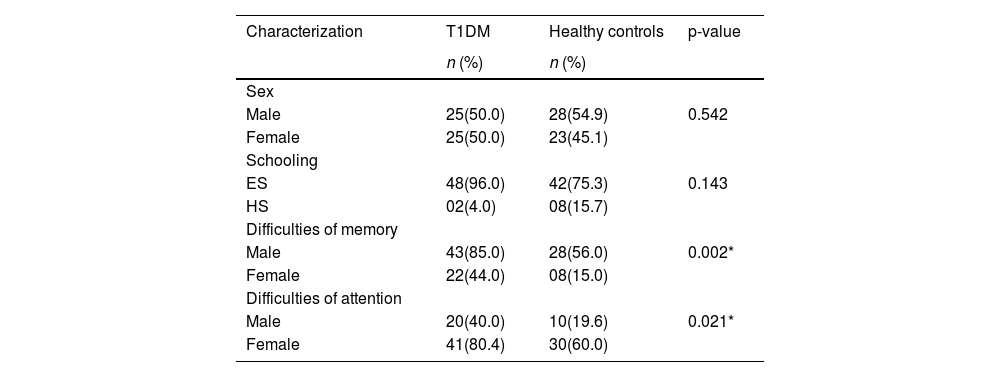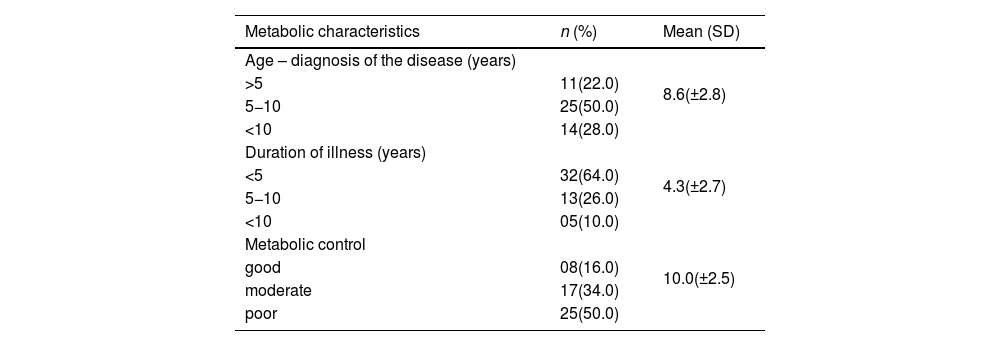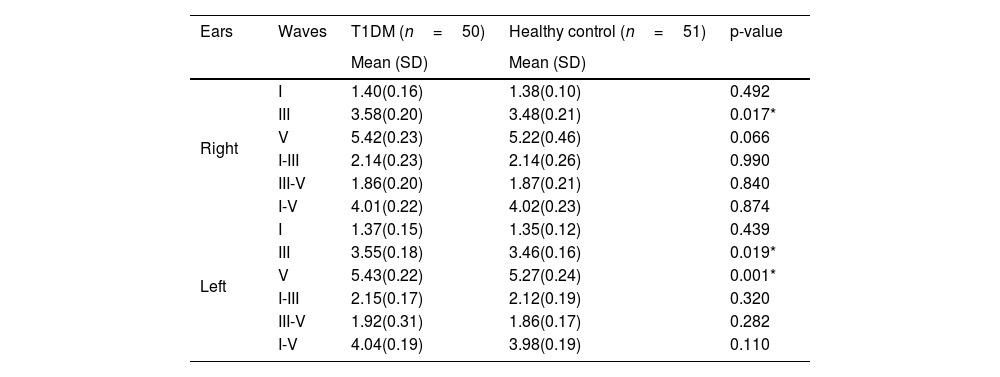Evidence has shown a cause-and-effect relationship between type 1 diabetes mellitus and auditory and cognitive dysfunctions. This study aimed to investigate the effect of type 1 diabetes mellitus (T1DM) on central auditory and cognitive functions in school-age children and adolescents.
MethodsThe study sample consisted of 101 children and adolescents, 50 with T1DM, of both sexes, aged between 7 and 18 years. All participants were selected for a structured interview on hearing, behavioral, and cognitive health and assessment of brainstem auditory evoked potentials (BAEP) and event-related potentials (P300).
ResultsSignificant differences were observed in memory (p=0.002) and attention (p=0.021) complaints between participants with and without T1DM. In the BAEP responses, there were differences between wave III latencies in the right (p=0.017) and left (p=0.019) ears and in wave V latencies in the left ear (p=0.001) between the evaluated groups. In addition, there was an association between BAEP findings and metabolic control in the T1DM group in the left ear in waves III (p=0.006) and V (p=0.005) and in the right ear in wave V (p=0.026). No differences were observed in the latencies of P300 between the evaluated groups.
ConclusionThis study demonstrated the existence of a subclinical finding in the central auditory pathway, offering an increased risk for retrocollear alterations, which may be a consequence of poor metabolic control.
La evidencia ha demostrado una relación de causa y efecto entre la diabetes mellitus tipo 1 y las disfunciones auditivas y cognitivas. Este estudio tuvo como objetivo investigar el efecto de la diabetes mellitus tipo 1 (DM1) en las funciones cognitivas y auditivas centrales en niños y adolescentes en edad escolar.
MétodosLa muestra del estudio estuvo constituida por 101 niños y adolescentes, 50 con DM1, de ambos sexos, con edades entre 7 y 18 años. Todos los participantes fueron seleccionados para una entrevista estructurada sobre la salud auditiva, conductual y cognitiva y la evaluación de los potenciales evocados auditivos del tronco encefálico (BAEP) y los potenciales relacionados con eventos (P300).
ResultadosSe observaron diferencias significativas en quejas de memoria (p=0,002) y atención (p=0,021) entre participantes con y sin DM1. En las respuestas BAEP, hubo diferencias entre las latencias de la onda III en el oído derecho (p=0,017) e izquierdo (p=0,019) y en las latencias de la onda V en el oído izquierdo (p=0,001) entre los grupos evaluados. Además, hubo asociación entre los hallazgos de PEATC y el control metabólico en el grupo de DM1 en el oído izquierdo en las ondas III (p=0,006) y V (p=0,005) y en el oído derecho en la onda V (p=0,026). No se observaron diferencias en las latencias de P300 entre los grupos evaluados.
ConclusiónEste estudio demostró la existencia de un hallazgo subclínico en la vía auditiva central, ofreciendo un mayor riesgo de alteraciones retrocollar, lo que puede ser consecuencia de un mal control metabólico.
Artículo
Comprando el artículo el PDF del mismo podrá ser descargado
Precio 19,34 €
Comprar ahora









